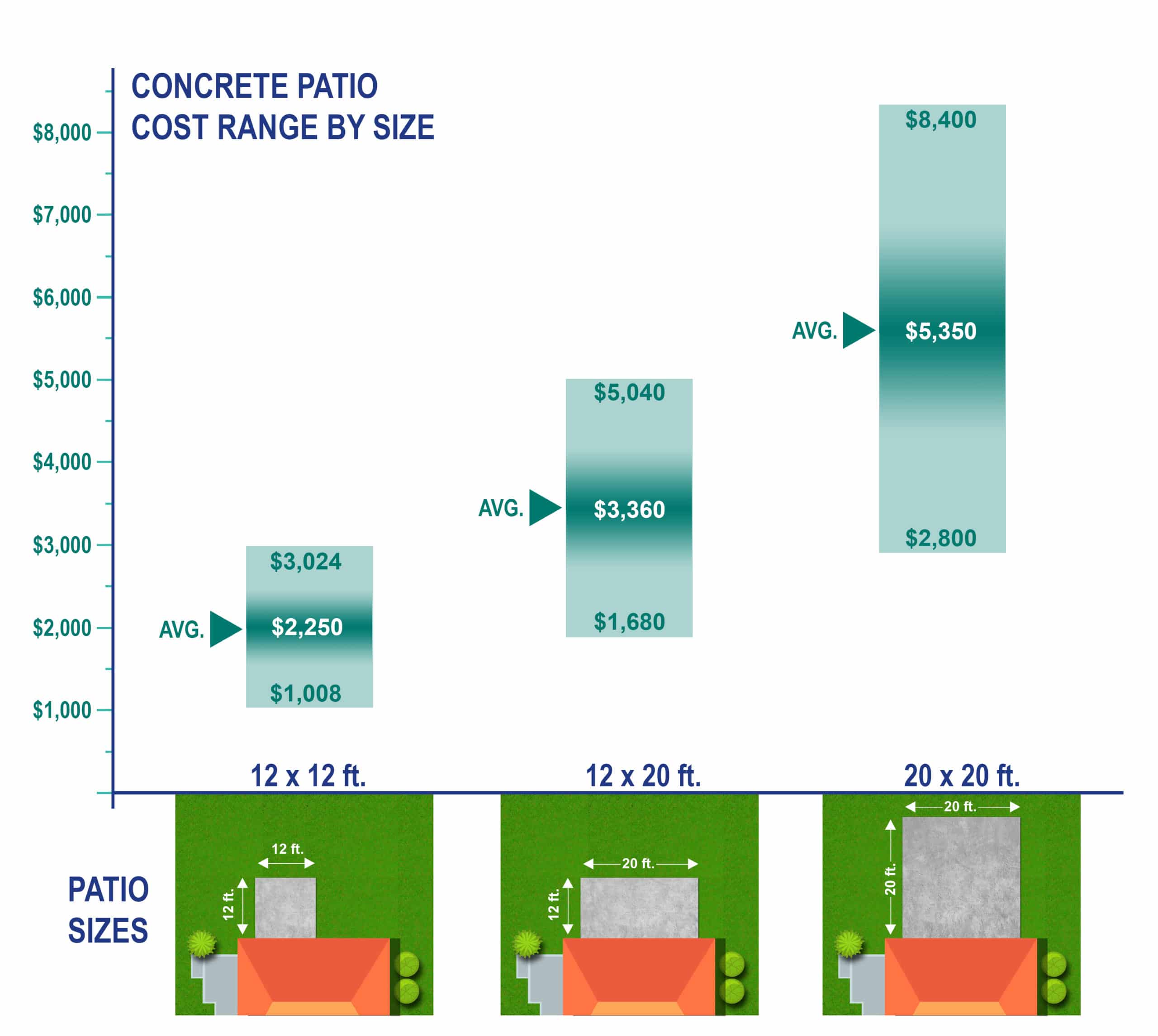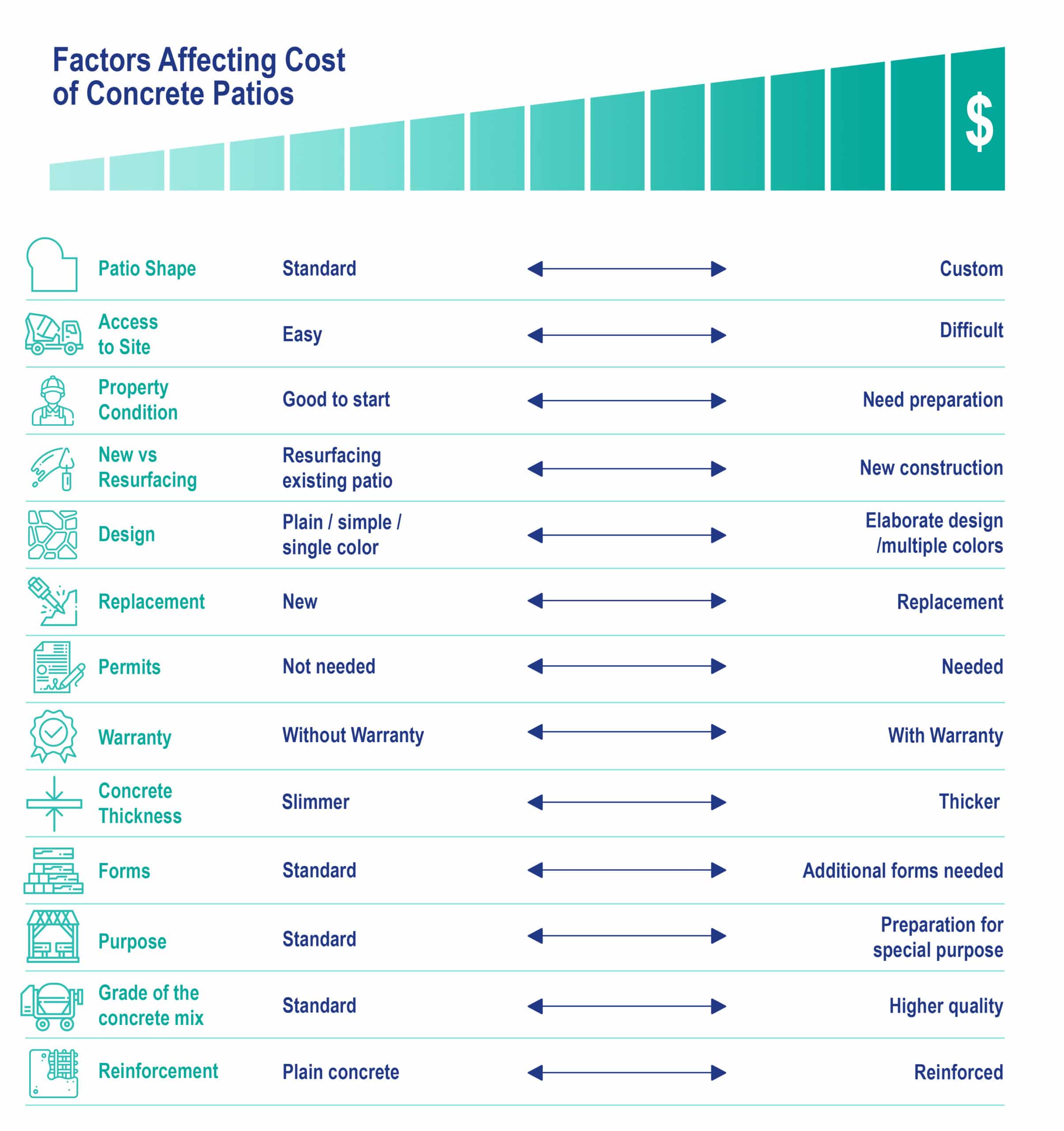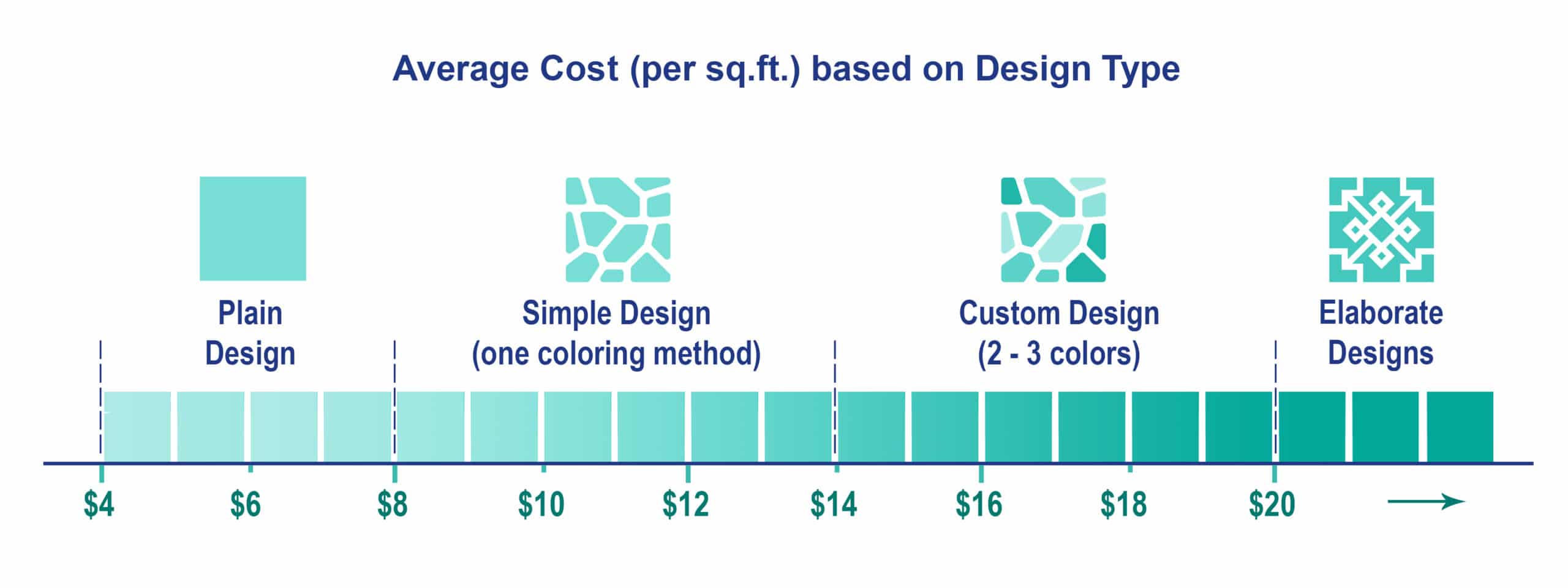A concrete patio provides an ideal space for lounging purposes as well as entertaining guests. With that in mind, more homeowners are making it a priority to have this pleasant and welcoming outdoor space added to your home.
If you have wondered about "how much does a concrete patio cost" at some point– lucky for you, we got you covered. Let's find out why many consider a concrete patio to be a significant, cost-efficient home improvement project.
On a square foot basis, concrete patios cost $7 to $21 per square. The average cost of a concrete patio ranges from $2,238 to $5,976. It applies to standard-sized patios that measure 288 sq ft.
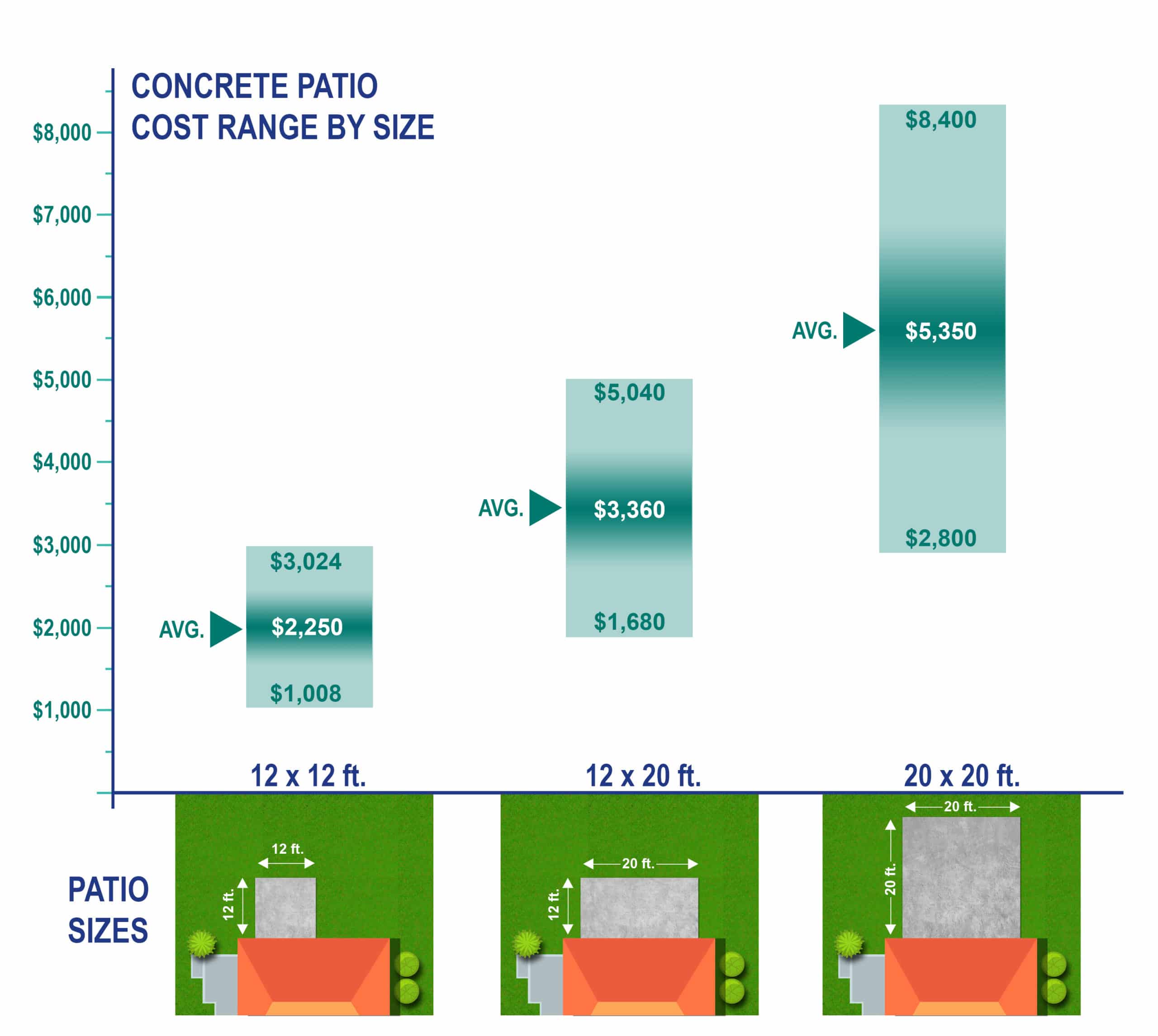
Access to the work area, excavation, leveling and local market conditions make the price. Keep in mind that this general estimate may increase or decrease, depending on several factors, such as your property location, design, and scope of your patio project.
Get at least three quotes from different concrete patio contractors in your area if you want to make the most bang out of your buck. Use the price points to calculate the local average cost of concrete patio.
Cost Per Scale
The total costs of your home concrete patio project will heavily depend on your desired patio size. Three of the most common patio sizes are small (12 x 12 ft.), medium (10 x 20 ft.), and large (20 x 20 ft.). It will cost you somewhere between $1,730 and $3,650. Refer to the table below for a quick overview of patio project costs per scale:
Concrete Patio Size | Dimensions (ft) | Average Costs |
|---|---|---|
Small | 12 x 12 | $2,335 |
Medium | 10 x 20 | $2,902 |
Large | 20 x 20 | $4,927 |
Another primary variable in determining the total expenses of a concrete patio installation will be its design. There are several finishes you can choose from at different price points.
Patio Design Type | Average Costs (per square foot) |
|---|---|
Plain Design (No decorative finishes or colors) | $4 to $8 |
Simple Design (Includes one coloring method) | $8 to $14 |
Custom Design (2-3 colors) | $14 to $20 |
Elaborate Design | $20+ |
Cost Per Square Foot
Plain, standard concrete patios will cost you around $6 per square foot. More intricate designs, finishes, or patterns may range up to more than $20 per square foot.
This cost-efficient patio material is known for its durability and anti-heat absorption properties. Hence, it suits properties located in warm regions well. With proper maintenance, your concrete patio can last up to fifty years without the need for resurfacing or resealing.
Factors Affecting Concrete Patio Cost
Here are some of the defining variables that influence the total costs of a concrete patio project at home:
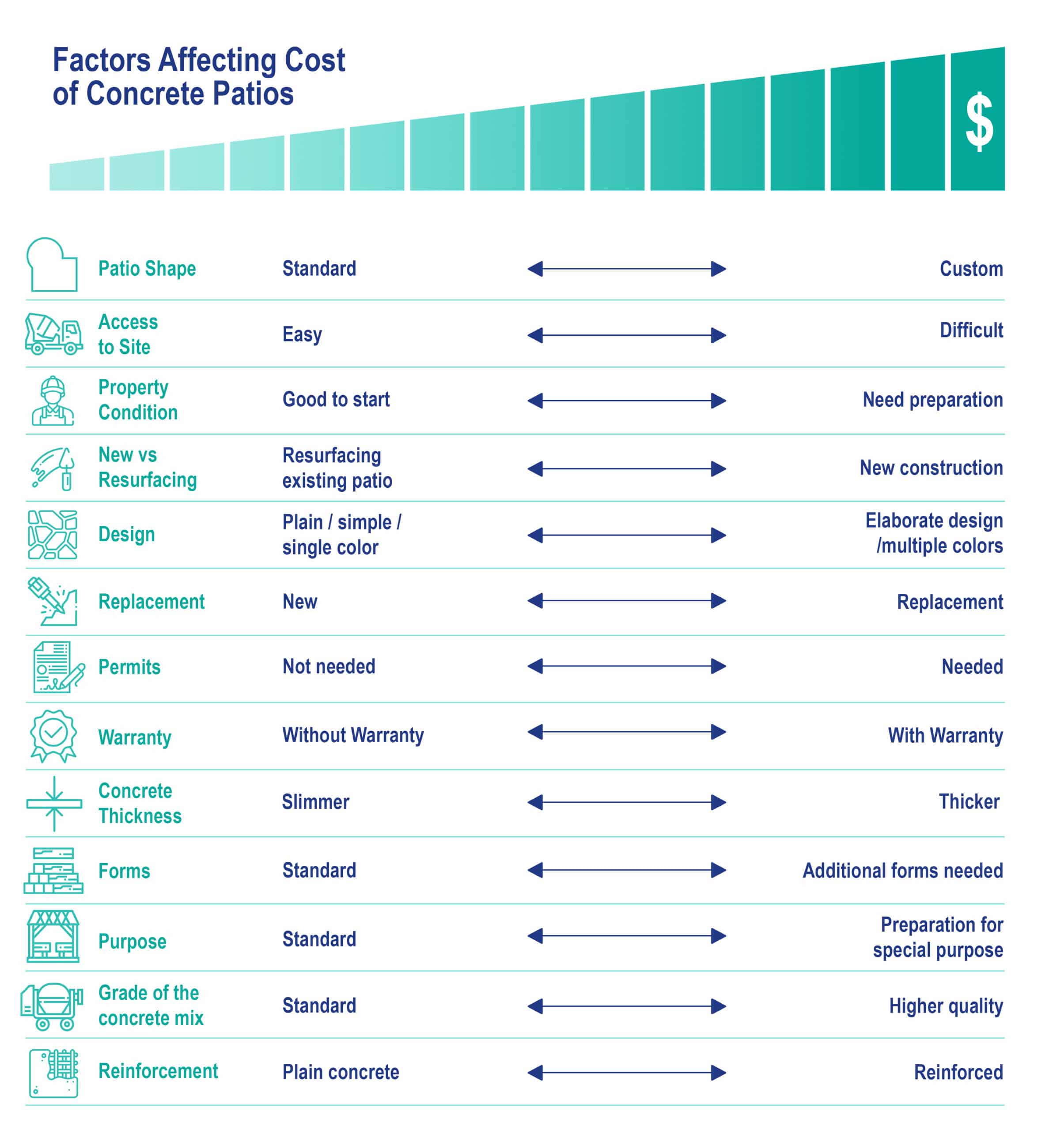
1. Size of Patio
First, you will need to determine the size of the space you want to install a concrete patio on. It will influence the total costs of the home improvement project. For small patios, take note that local contractors may charge you a minimum total instead of the standard per sq/ft rate.
Here's a quick rundown of the standard patio sizes in the home and their average total costs:
Patio Size in ft. | Average Price |
|---|---|
10 x 10 | $1,215 to $3,510 |
12 x 12 | $1,620 to $4,050 |
12 x 14 | $1,890 to $5,400 |
15 x 15 | $2,430 to $7,500 |
16 x 18 | $3,105 to $9,720 |
20 x 20 | $4,000 to $13,500 |
The starting prices are for entry-level concrete patios, whereas the price at the higher end of the scale typically features elaborate color, stamps, and textures.
After determining the location of the slab, take the perimeter measurement to get an estimate of the square footage. Doing so will help you form a budget for the material and labor costs.
Adding a patio to your home will instantly make the place appear more spacious. Depending on your intended size to fit your home patio needs, you can count on this space to serve as a relaxation spot.
2. Shape of Patio
If you think plain square or rectangular patio shapes are pretty bland choices, you can take your space to the next level by opting for unique, custom patio shapes instead. However, customization will likely increase the total installation costs further. On average, the hourly rate for concrete labor is $60. Personalized designs will cost more than that.
The total price depends on the complexity of the curves and design and the extended duration of forming the patio shape itself. Consult your contractor about your creative vision to know if it's possible and fits within the budget.
3. Ease of Access
The ease of access to the installation site also affects the total price of your patio project. For instance, if your chosen space can be easily reached by the equipment or truck for concrete pouring – there won’t be any additional charges. If the site is located in the far back of the house that’s quite difficult to reach, your contractor will typically charge you more as the task is more challenging than usual.
Difficult installations may add an extra hundreds or thousands into your patio installation costs. It’s best to consult at least three patio service providers in your location to find out the lowest fees possible for your situation.
4. Property Condition
The current condition of your property may influence the budget you need for this project. In particular, homes that require demolition, land excavation, grading, or other relevant on-site work may need to pay their local contractor more for the additional work.
5. New Patio Installation vs. Patio Resurfacing
You can set up a concrete patio at home in two ways: (1) New installation (which ranges from $4 to $20 per sq ft or more), and (2) patio resurfacing. In some cases, resurfacing your existing patio is enough to make it look brand new. It’ll cost you less than a total replacement, ranging from $4 and $13 per square foot.
6. Design
Here are some of the most popular design options for concrete patio projects.
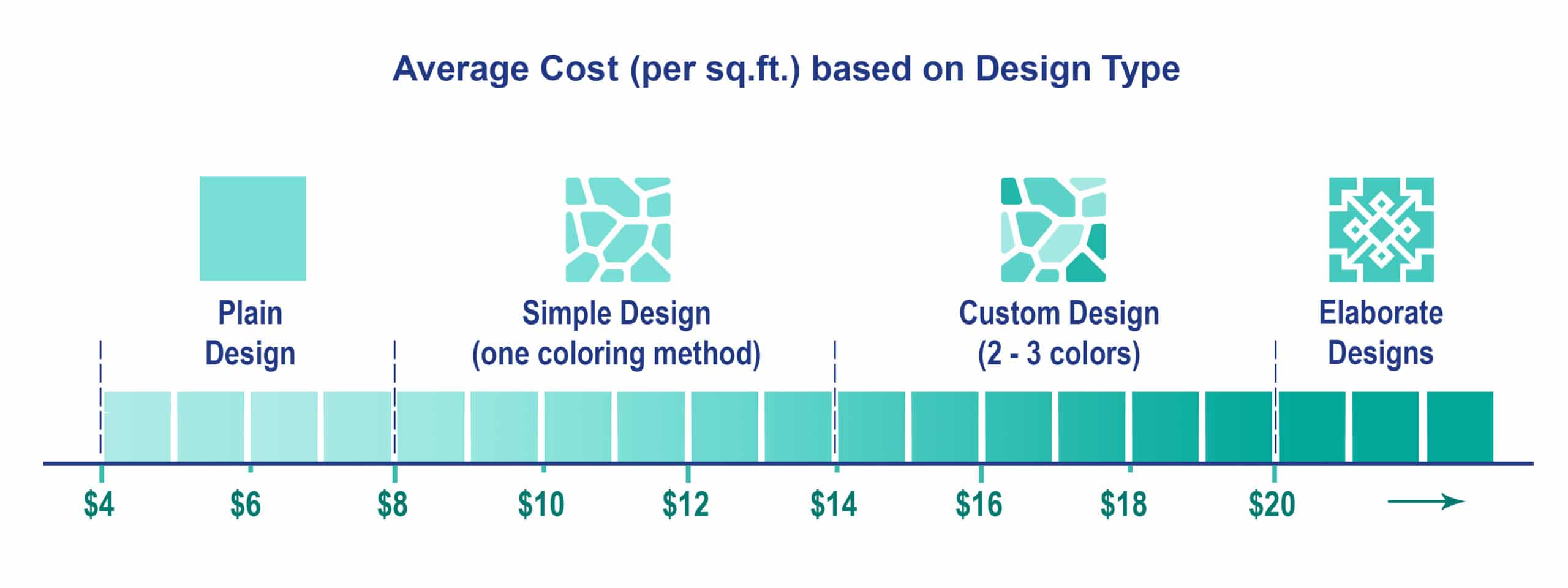
7. Concrete Patio Replacement
If you plan to replace your old, worn-out concrete patios – your contractor may charge you extra in removing existing concrete. Expect this service to range from $742 to $2,126.
The total of concrete removal will depend on the total size and thickness of the slab and any disposal fees.
8. Permits
Before you begin your concrete patio project, it's best to determine all the necessary local government or homeowner's association (HOA) permits involved. These permits range from $202 to $405 on average. You won't need a building permit in some cases, but your contractor may need to secure an excavation permit for the patio installation work.
The project involves changing the amount of surrounding permeable ground in your property, which may affect water runoff and affect the people around you in the process.
9. Warranty
Some concrete installation companies offer warranties for patio projects at an additional cost, depending on your location, the warranty duration, and the extent of the damage covered. We typically don’t recommend choosing additional warranties as most companies (all of them in our opinion) write the warranty to exclude most things that could practically happen.
For example one warranty we found covers cracks over 0.25”. That’s a big crack and it would be extremely unlikely. Keep in mind all concrete will crack. Rather than the warranty, focus on the companies’ specified compaction method.
10. Thickness
In any patio installation project, the thickness of the slab is one defining variable in the total project costs. Refer to the table below for a quick pricing overview on specific patio thickness:
Patio Thickness | Average Cost (Per square foot) |
|---|---|
4 inches | $7.2 |
5 inches | $7.8 |
6 inches | $8.3 |
Ideally, the minimum thickness of your new concrete patio should be around 4 inches, which will cost you $7.2 per square foot on average.
You may also opt to have it up to 6 inches in thickness, running at $8.3 per square foot. The thicker your concrete slab, the more durable it will be for frequent, daily use. Technically, you will pay a higher rate per square foot for thicker patio projects as it requires more materials and more prolonged labor.
11. Forms
Concrete pours for your new patio will need forms. Depending on your desired thickness and the local price of lumber, the cost to pour concrete patio is between $54 and $81 on 1 x 4 sized planks to build a standard twelve-foot form. This estimate includes the additional stakes and string you also need.
For spaces that need strong reinforcements, you will need to factor in the extra cost of rebar or wire mesh. Hiring professionals for this service starts at an hourly rate of $34, accumulating to $135 for typical half-day work.
12. Purpose
Your intended patio purpose will influence its total project costs. Simple backyard space for intimate social gatherings can be in the form of a regular slab, with structures and concrete as the only defining expenses.
Suppose you want your concrete patio to impress your visitors – such as potential customers. In that case, you might want to invest in a more high-end concrete patio installation with brick or flagstone.
If you might want to build a sunroom, pergola, or other outdoor structure on the patio structure, it is best to have footers added to the concrete patio.
One of the biggest regrets homeowners have regarding their patio, according to Corey Philip of Gulf Coast Aluminum, a sunroom contractor in Florida, is that they “did not know” they would need footers for a sunroom and now must spend thousands extra to after concrete cut and footers added after the fact.
13. Grade of Concrete or Concrete Mix Quality
The grade defines the quality of your concrete material. Specific ingredient ratio will determine its overall durability as a mixture of cement, loose aggregates, sand, and water. On average, ideal grades range from $135 to $202.
Remember that an uncovered patio is constantly exposed to extreme heat, heavy rains, and brutal cold in winter. Ensure to choose a top-quality concrete mix that is durable enough to stand through wear and tear as well as harsh weather conditions.
Determining the concrete grade helps professional installers determine an ideal mix for specific projects. It is measured in newtons after 28 days of setting the patio. Given that the quality of concrete varies with every mixture, expect higher-quality concrete grades to be more expensive than the standard grade ones.
14. Reinforcements
You will need reinforcements in your concrete mixture to improve its innate durability and strength. It includes a wire mesh, rebar, styrofoam, or a vapor barrier. Reinforced concrete is expected to last in its prime condition over a long time. These improved features will cost you more than a standard concrete slab with no reinforcements – ranging between $9.29 to $10.04 per square foot.
Take note that the cost estimate does not include additional custom patio finishes or designs. These are only for basic, rectangular poured concrete slabs.
Why Use Concrete Instead of Other Patio Material?
You might be wondering, what makes concrete a more desirable option versus other materials? Would you benefit more from a concrete patio than a brick, stone, or tile patio? For one, this is a cost-effective option for many homeowners. If you're working with a limited budget, you'll benefit from concrete material as it is pretty cheap and easier to install.
There's also a wide range of available colors and patterns in concrete material. Stamped concrete patio cost, which is a considerably decorative slab, is one-third less than you would pay for other decorative patio material. (Related article: Cost Guide: Concrete For Patio And Driveway)
If you're still unconvinced if the concrete is the best material for your patio needs, here are some of its main draws:
Concrete Patio Project Process
For your reference, let's discuss the concrete patio process in detail:

1. Removal
Generally, the first step in a concrete patio installation involves the removal of an existing patio. It also includes site preparation and the removal of debris. The crushed, old concrete can be repurposed as different things: base for a simple pavement, aggregate material, or a granular refill. Local disposal fees start at $135 per ton, including transportation.
2. Sub Base & Grading
The next step in the process is sub grading. It is preparing the soil area located below the patio slab. Professionals can help you ensure the concrete will not crack upon settling – given their expertise and experience in the matter.
Typically, they excavate the area and remove any rocks in the area. Surrounding saturated rocks and soft soils are also taken away. Instead, professionals either work with suitable soil in the area or bring in alternative options such as uniform, crushed stones, or gravel.
The soil base is compacted to a minimum of 6 inches in height, making it ready for poured concrete. Afterward, the soil is poured with a layer of sand or compact gravel. According to Corey Philip, contractor of Gulf Coast Aluminum in southwest Florida “most issues with cracked or settling concrete occur due poor or lack of compaction”. “On a concrete patio, ensure that you see a power tamper brought out and used to compact the area before concrete is poured” he adds.
It is essential to have subgrade soil to give your patio a firm, sufficient base. Doing so enables the slab to carry the weight of its surface area. And if you stumble across drainage issues, it's best to solve these problems at once. You wouldn't want water to pool around the concrete slab and erode the subgrade beneath it. Local regulations for home patio construction vary depending on your location. Regardless, it generally requires compact testing to measure its strength.
If you live in a region where the soil freezes for most of the winter, the patio subgrade foundation must ideally be below the frost line. It ensures stability when the snow and ground finally thaw out.
For locations with a deeper frost line requirement, expect the total costs to be more expensive (at an additional $2.5 per square foot). You will need to spend more if you want your subgrade to be as sturdy as possible.
3. Forming
With the base ready form boards will be set place that will hold the concrete once it is poured until it finishes drying (hardens). It is critical that the form boards are level, or sloped in the planned direction for drainage. If this is not done correctly, the only solution is often removal of the concrete.
4. Pouring
When the day comes to actually pour the concrete into place, the contractor may either do it by ‘hand’ mixing bags of concrete on site, or utilizing a concrete ‘mud’ order which will come in a big cylinder truck.
If the concrete comes by truck, typically a pump will also be independently contracted to get the mud from the truck parked on the road, to the back of the home. Once the concrete is in place it will be leveled and spread evenly until it hardens.
5. Concrete Patio Sealer
Finally, you will need to seal your concrete patio at this stage in the process – especially if you foresee a lot of mealtime get-togethers in the area. Concrete does not typically need sealing but doing so helps you avoid stains. Unwanted marks are challenging to erase, given a concrete's porous nature.
In particular, you can opt for an acrylic spray-on cure and seal, which runs at $0.7 per square foot. Unlike epoxies, acrylic sealers do not fade to yellow even with constant sunlight exposure.
Since two should have double applications, ideally a non-metallic color and concrete hardener, this will cost around $3.2 per square foot.
Landscape Ideas for a Concrete Patio
Are you looking for creative ideas to blend your existing backyard landscape with your new concrete patio? Well, below are some landscape tips to strike a beautiful balance: If you’re planning to include shade in your patio, you may need to have shade covers.
Several fabric sail shades are readily accessible in the market, including aluminum or wood covering for decks. Relying on trees and your garden greenery alone for natural shade won’t suffice – most take long years to mature and give you the consistent shade you need.
For great plant ideas: grow pergolas. You may use the growing vines to create a denser shade in your patio. You may also use the existing greenery in your backyard garden to create a balance with the new hardscape. Use grass lines as well as groundcovers to give pathway breaks in between patios. It avoids the impression of over-decorating your new concrete patio.
There’s also the option of putting flower beds between the home or walls and the patio area. For instance, narrow 24-inch plant beds can effectively soften the patio edges. It will also make your yard cozier and more inviting to your neighbors, especially with the garden appeal.
Checklist in Hiring a Professional
A professional concrete patio installation will approximately cost you $2.7 to $10.8 per square foot. If you’re thinking of doing a DIY project, be cautious as an improper or poor patio installation will lead to concrete surface cracking. That’s the last thing you’d want to happen.
So, if you don’t have extensive experience in mixing concrete and pouring into slabs, hiring local concrete patio contractors proves to be the better choice. Here are some pro tips to keep in mind in choosing a professional patio service provider:
Frequently Asked Questions (FAQs)
Is poured concrete cheaper than pavers?
Yes, poured concrete is the cheapest material available per square foot, costing between $5 to $8. Meanwhile, pavers might be more expensive ranging from $5 to $27, but it also offers more durability and various designs and colors to choose from. Despite the cheaper concrete patio cost vs pavers, adding customizations such as stamping makes the expenses comparable.
Do concrete pavers turn slippery when wet?
Not all pavers are slippery. A textured surface provides stability and traction when installed in driveways, walkways, and pool decks. Contrary to what people thought, concrete pavers are recommended because they are not slippery when wet.
How do I determine the ideal size of concrete patio for my needs?
You can effectively estimate an ideal patio depending on your budget and its use. For instance, a common bistro space can only be as little as 100 square feet, while a large dining area consisting of grill and lounge furniture can be larger than 400 feet.
What can I do to make my concrete patio look better?
Here is the list of customizations and add-ons you can apply to upgrade the aesthetics of your concrete patio such as curved borders, Customized stencils, saw cuts to create a faux tile appearance, Multi-storied levels, Stairs, and Texturing to create a faux-stone appearance.
Final Thoughts
Undoubtedly, installing a home concrete patio provides a relaxing outdoor space for personal lounging or social gatherings. Not to mention, it also improves your home's visual appeal as well as its value on the market.
Make the most out of your new concrete patio installation by leaving the work in the hands of experts. They can guarantee a flawless patio project with generous warranties in some cases. Contact a local patio professional near you today!


